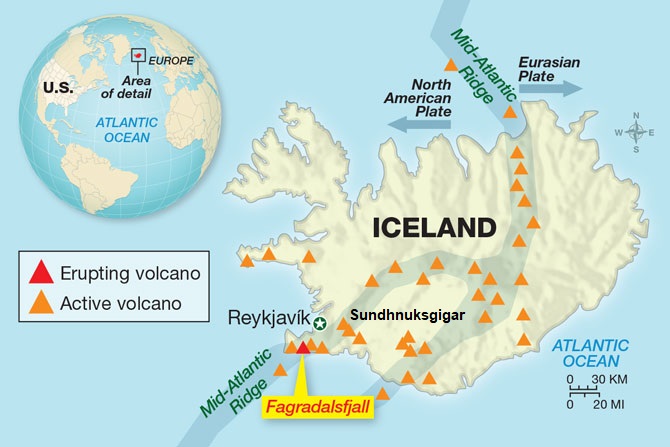Note4Students
From UPSC perspective, the following things are important :
Prelims level: Frequent Volcanic eruptions this year, Sundhnuksgigar and other Volcanoes Why in the News?

Why in the News?
Southwest Iceland witnessed the eruption of the Sundhnuksgigar volcano, triggering evacuations in the nearby areas.
About Sundhnuksgigar Volcano
- Sundhnuksgigar is a row of craters just outside the town of Grindavik on the Reykjanes peninsula
- It is situated on the Mid-Atlantic Ridge, a divergent boundary where the Eurasian and North American tectonic plates are moving apart.
What is a Volcano?
Different types of volcanoes can be classified based on the frequency of eruption and the nature of the eruption:1. Frequency of eruption:
2. Nature of Eruption:
|
Reasons for Iceland’s Volcanism
- Tectonic Activity: Iceland is situated on the Mid-Atlantic Ridge, where the Eurasian and North American plates diverge. This creates volcanic rift zones where magma rises to the surface, leading to eruptions.
- Hotspots: Additionally, Iceland is positioned over a hotspot, contributing to heightened volcanic activity. Hotspots are areas where magma from the mantle rises towards the surface, fueling eruptions.
- Subglacial Volcanism: Iceland’s volcanic activity is not limited to the surface; some eruptions occur beneath glaciers, leading to explosive interactions between lava and ice. These subglacial eruptions can produce powerful steam explosions, ash clouds, and catastrophic floods known as jokulhlaup.
PYQ:[2021] Mention the global occurrence of volcanic eruptions in 2021 and their impact on the regional environment. [2013] Consider the following:
Which of the above are responsible for bringing dynamic changes on the surface of the earth? (a) 1, 2, 3 and 4 only (b) 1, 3, 5 and 6 only (c) 2, 4, 5 and 6 only (d) 1, 2, 3, 4, 5 and 6 |
Get an IAS/IPS ranker as your 1: 1 personal mentor for UPSC 2024

